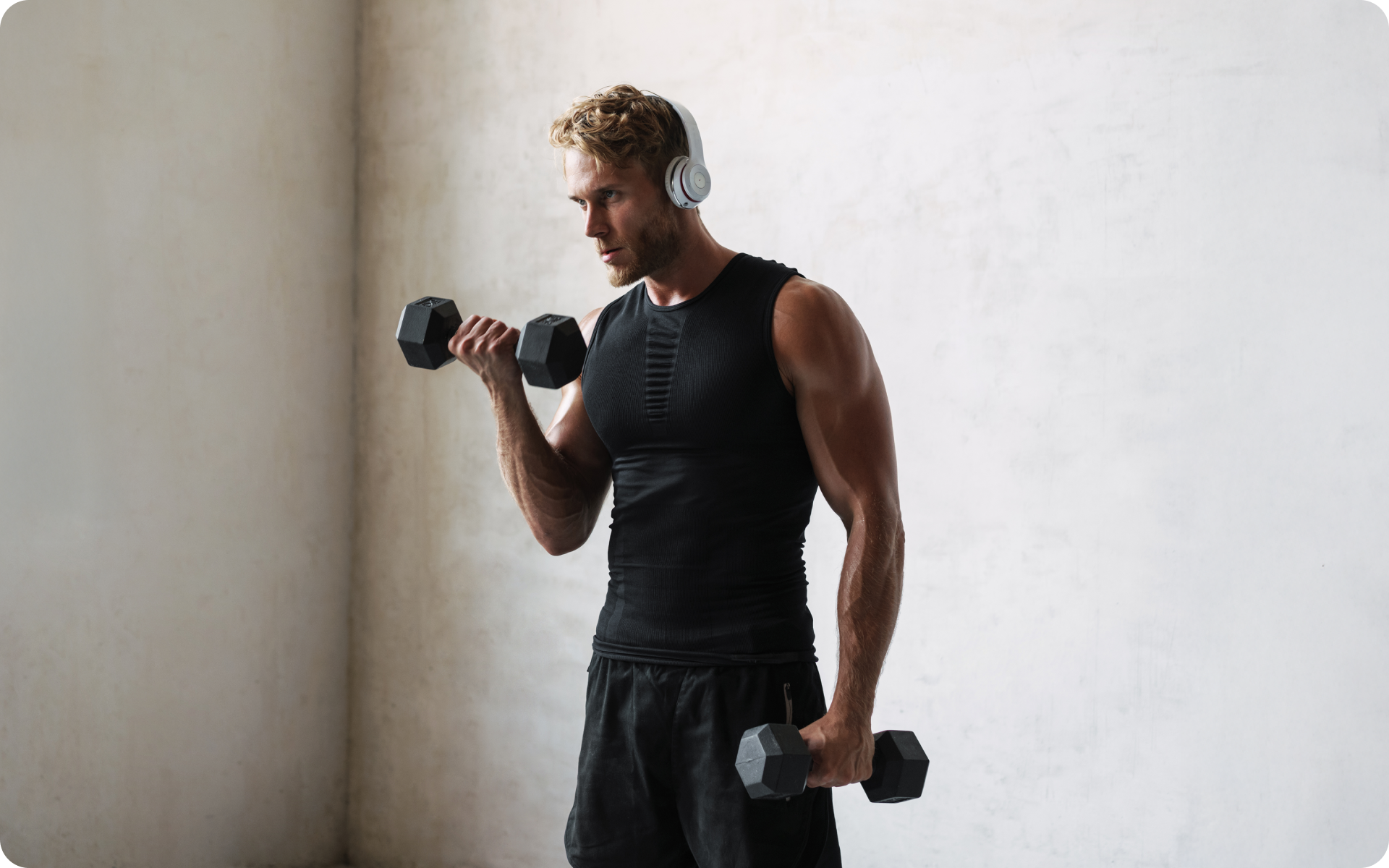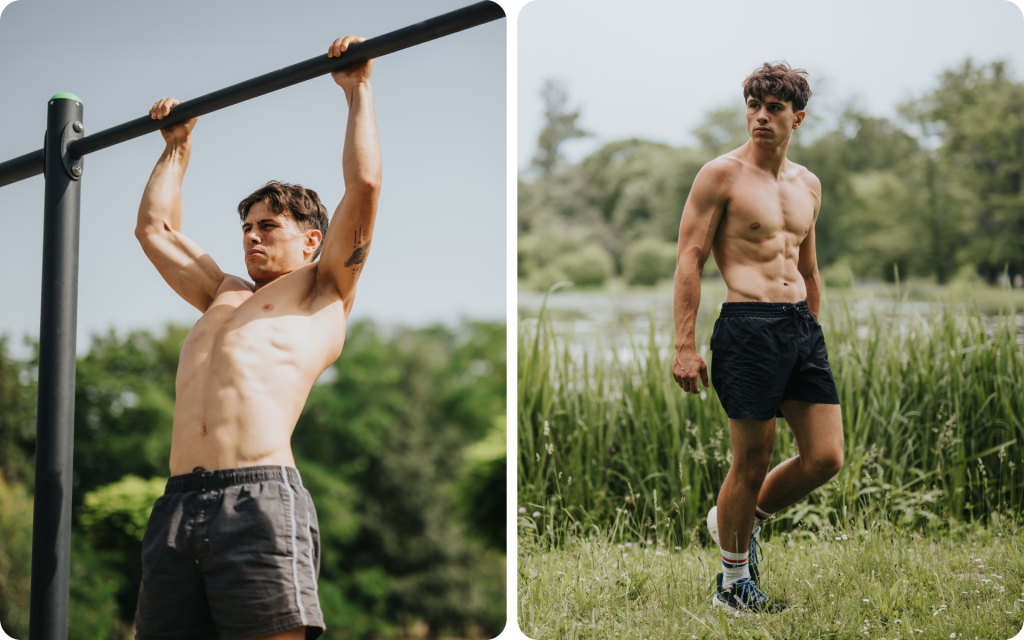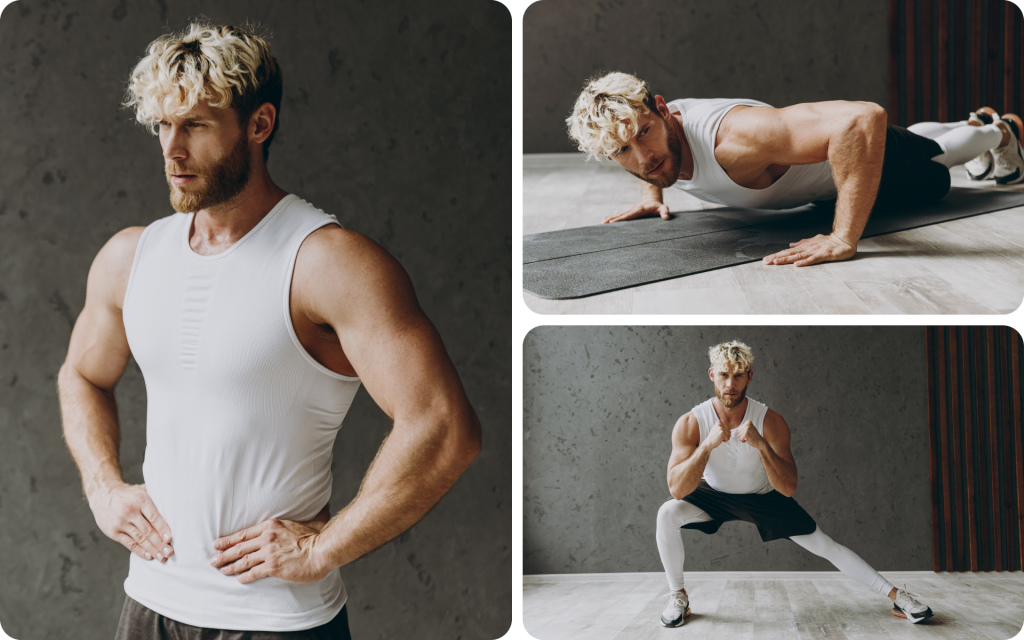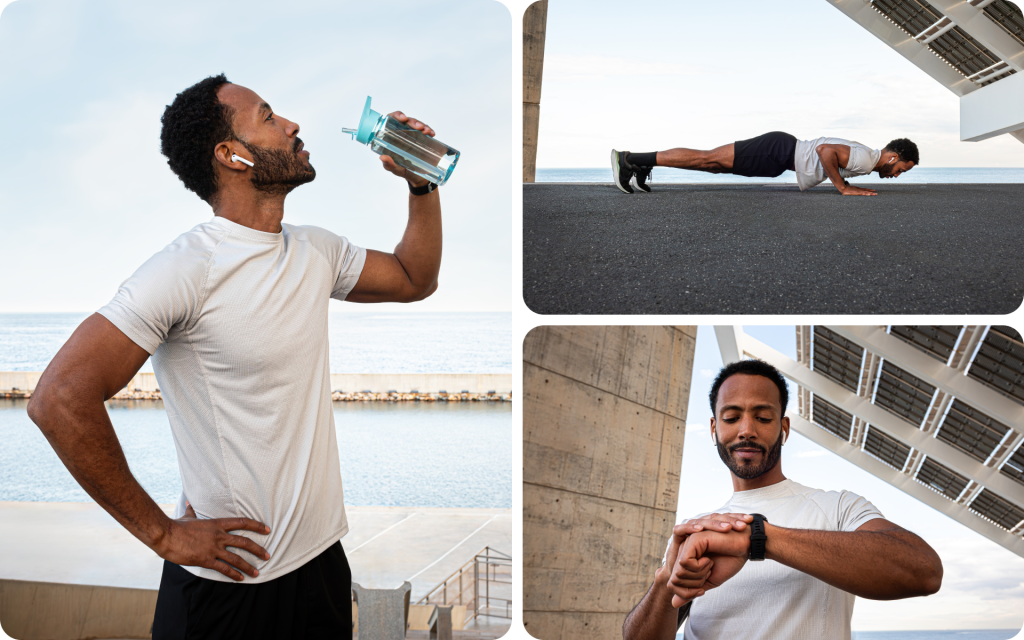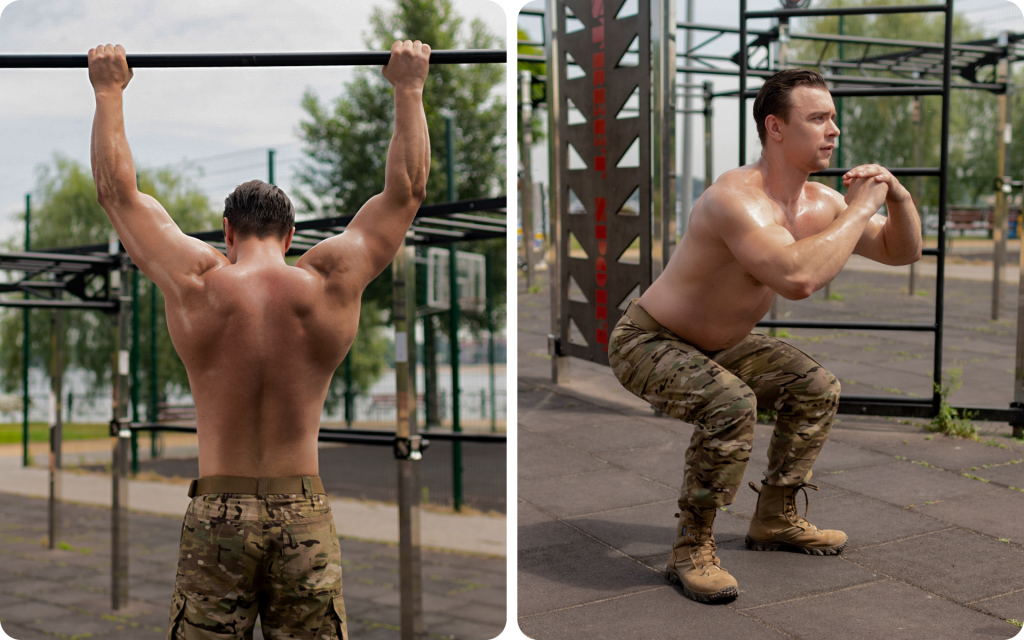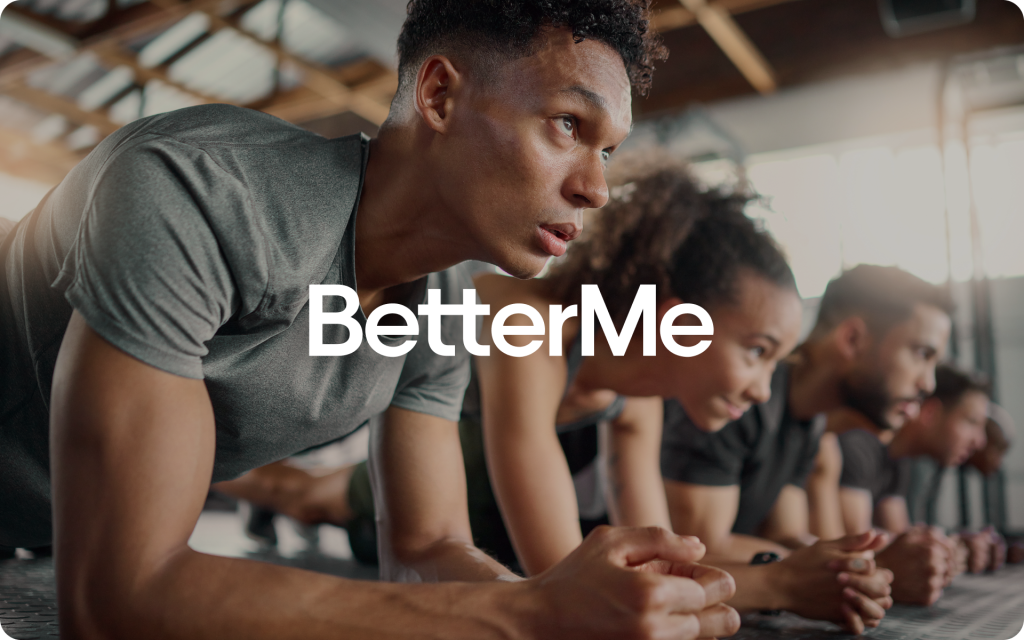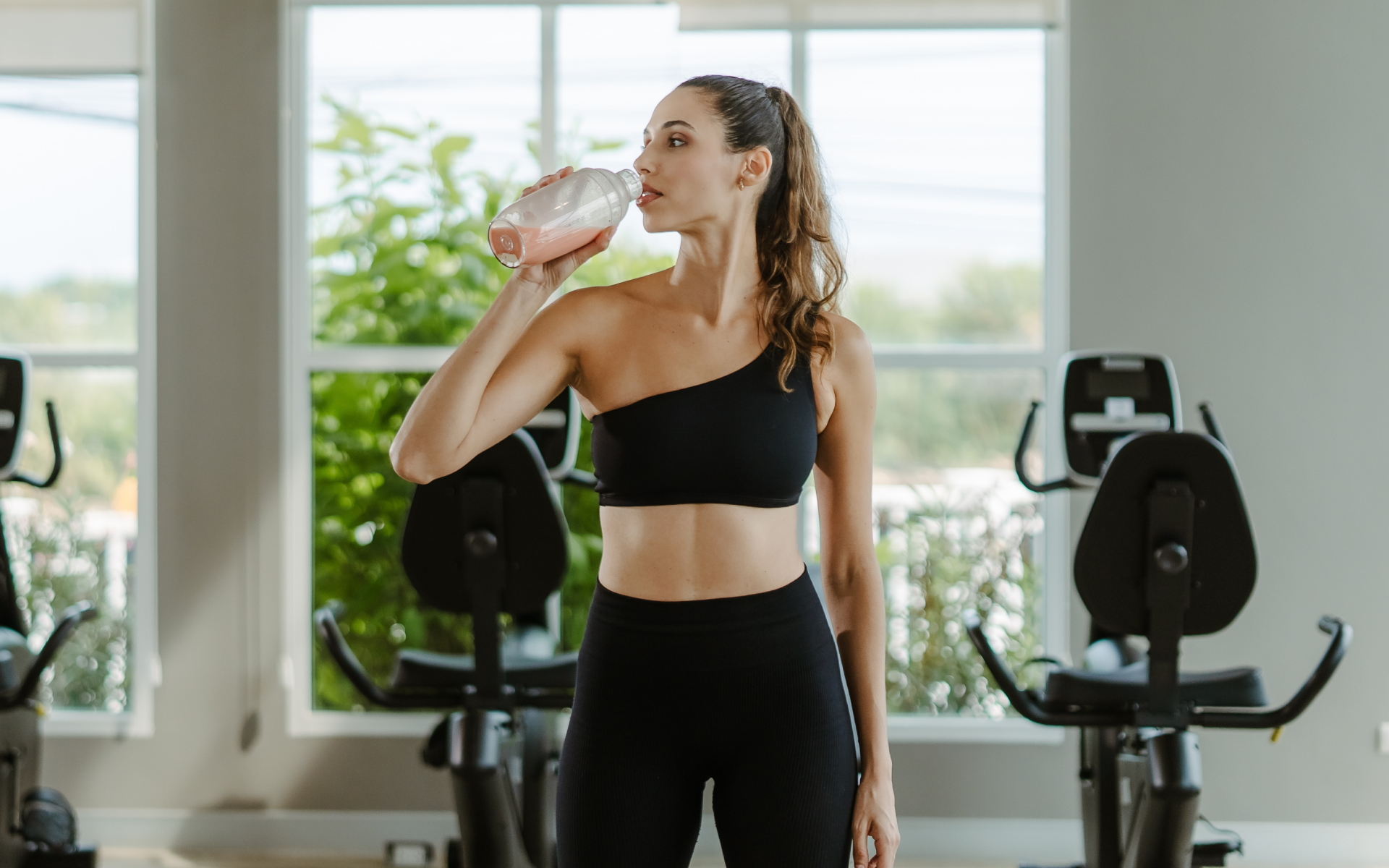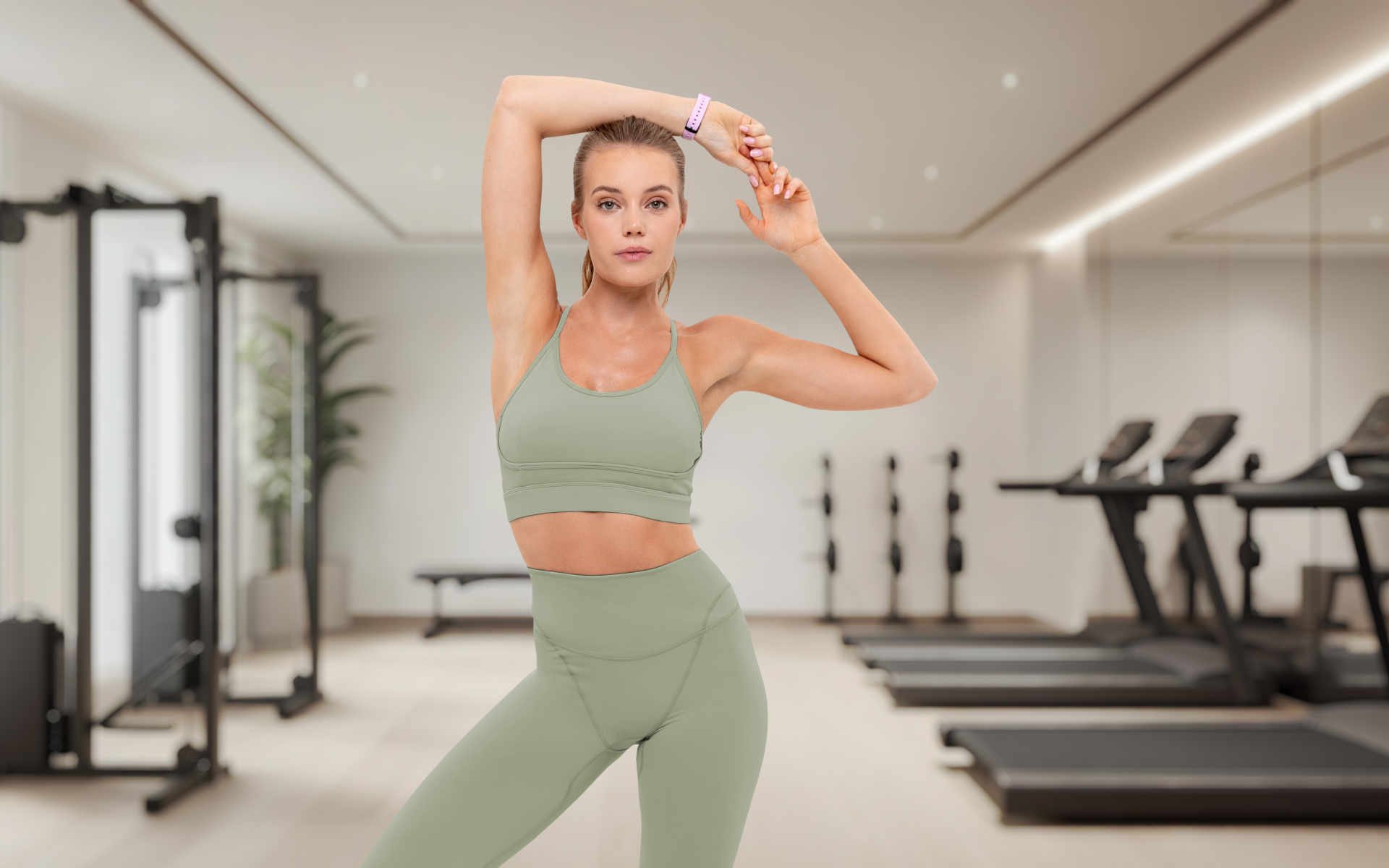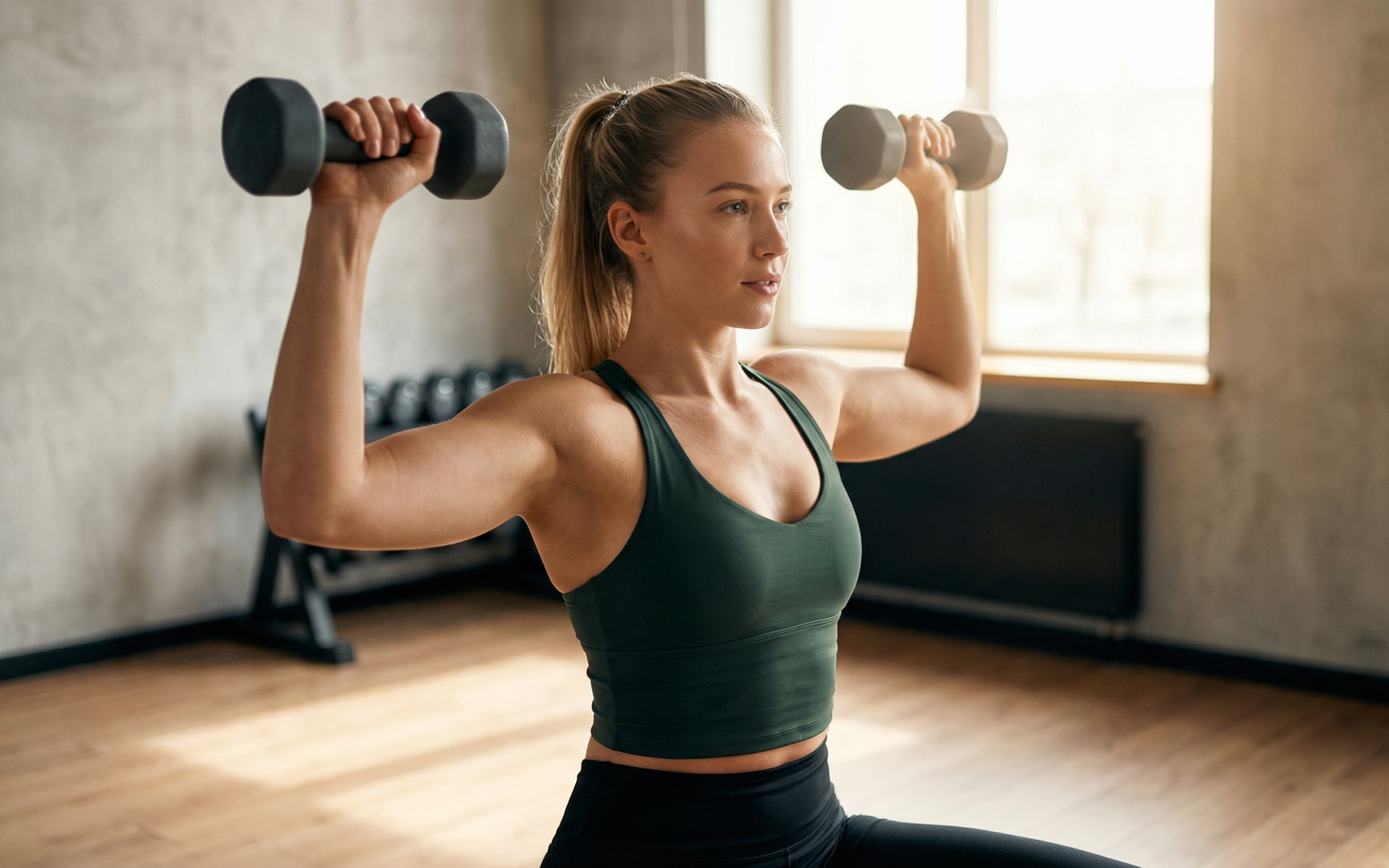Instead of working your entire body every session, a split training approach divides your workouts by specific muscle groups or movement patterns. It’s an efficient strategy to target muscles more effectively, recover smarter, and ultimately, maximize your results (1).
But the options can feel overwhelming, leaving many beginners wondering, Where do I even start?
A 3-day upper-lower-full-body split is one option.
Simple, time-efficient, and backed by science, this split is perfect for those who are new to structured training. By alternating focus between your upper body, lower body, and full-body training, you can hit all major muscle groups, optimize recovery, and lay a solid foundation for long-term progress.
This guide is your step-by-step introduction to split training with a 3-day upper-lower-full-body routine.
What Is an Upper-Lower-Full-Body Split Workout Structure?
An upper-lower-full-body split is a workout structure that divides training sessions into three distinct focuses over the course of a week. Each session targets different areas of the body or movement patterns to ensure balanced development, optimal recovery, and efficient use of training time.
The purpose of this structure is to provide full coverage of major muscle groups while also allowing adequate recovery between sessions. By alternating the focus between upper-body, lower-body, and full-body movements, you can prevent overtraining and maintain balance in your development.
This split is particularly valuable for those who want to build overall strength, muscle coordination, and endurance in a time-efficient way.
It’s a strategic and versatile setup that is suitable for beginners who are building foundational strength or individuals who are looking for a well-rounded, low-frequency training schedule.
Here’s how it’s typically organized:
- Upper-Body Day
This session focuses exclusively on exercises that target the upper body. These include movements for the chest, back, shoulders, biceps, and triceps. Examples include bench presses, pull-ups, shoulder presses, and rows.
- Lower-Body Day
On this day, your attention shifts to the lower half of your body. It emphasizes strength-building and mobility for the legs and glutes. Key movements often include squats, deadlifts, lunges, and hamstring curls.
- Full-Body Day
The final session is designed to engage all the major muscle groups in a single workout. This combines compound lifts (such as deadlifts, squats, and overhead presses) and other multi-functional exercises. This day prioritizes overall coordination and muscular synergy.
Read more: Workout Plans For Men: A Complete Guide To Get You In Shape
Is the Upper-Lower-Full-Body Split a Recommended Split?
The upper-lower-full-body split is an effective and versatile training structure, particularly for beginners or those with limited weekly training time. It balances frequency, recovery, and intensity, which are key components of a well-designed workout routine.
Benefits:
- Efficient Use of Time
Training three times per week with this split allows you to target all major muscle groups without overwhelming your schedule. - Balanced Recovery
By focusing on specific areas in separate workouts (upper body, lower body, and full body), your muscles have adequate recovery time. This can reduce the risk of overtraining while still promoting growth and strength gains (2). - Foundation Building
For beginners, alternating focus between the upper and lower body establishes balanced strength and movement patterns. The full-body session reinforces coordination and synergy between muscle groups (3). - Adaptable Intensity
Exercise selection and intensity (e.g. weights used or volume of work) can easily be adjusted as your fitness improves, which makes this split suitable for both beginner progression and long-term use.
BetterMe: Health Coaching app helps you achieve your body goals with ease and efficiency by helping to choose proper meal plans and effective workouts. Start using our app and you will see good results in a short time.
Considerations:
- Lower Overall Volume Per Session
With fewer weekly sessions, each workout may require a higher overall workload to sufficiently train all major movements and muscles. This can be challenging to manage in a single session, particularly for beginners. - Less Specialization
Compared to splits that focus on fewer muscle groups per workout (e.g. a push-pull-legs split), an upper-lower-full-body split distributes training more broadly. This may limit the volume per muscle group within a single session, which could slow progress for more advanced lifters who are aiming for hypertrophy. - Consistency Is Key
To see results with this split, maintaining consistency week-to-week is essential. Missing a session could mean certain muscle groups don’t get worked as planned.
Is It Right for You?
Whether this split suits you depends on your goals and schedule. It’s particularly useful for beginners who are laying a solid foundation, or for individuals with three dedicated training days per week. However, if your goal is rapid muscle hypertrophy or skill-specific training (e.g. powerlifting), a different split with more targeted volume may be a better option.
Ultimately, the upper-lower-full-body split is a well-rounded choice for those who are looking for balance, recovery, and steady progress in a manageable timeframe.
Is an Upper-Lower-Full-Body Split Good for Cutting?
Cutting, or fat loss, requires a balance of preserving lean muscle mass and creating a calorie deficit (4, 5) all while managing fatigue. The upper-lower-full-body split is a practical, adaptable option for cutting. It helps maintain strength and muscle mass while allowing flexibility in recovery and energy management.
However, it may not suit individuals who need more frequent, lower-intensity sessions to balance fatigue or those with highly specific goals such as body recomposition on a tight timeline.
| Aspect | Details |
|---|---|
| Efficient Training Structure | Targets all major muscle groups in just three sessions per week, which saves energy for recovery during cutting |
| Preserves Muscle Mass | Compound movements provide the mechanical tension needed to maintain muscle, even in a calorie deficit (6) |
| Manageable Volume | Alternating focus across upper-, lower-, and full-body workouts prevents burnout and reduces fatigue |
| Supports Recovery | Recovery days built into this split help repair muscles and the nervous system during limited calorie phases (2) |
| Energy Levels | Reduced energy availability during cutting may affect performance - intensity adjustments may be needed (7) |
| Maintain Progressive Overload | Aim to maintain strength and volume by using moderate to heavy loads (8), avoiding declines in muscle retention |
| Account for Activity Levels | Incorporate cardio cautiously to balance overall workload and minimize the risk of overtraining |
Ultimately, the success of your cutting phase will depend on how well you balance training, nutrition, and recovery. This split offers a solid foundation, but you should always listen to your body and make adjustments as required to sustain progress and minimize burnout.
How to Balance Volume Between Upper- and Lower-Body Days
By tailoring the volume to your recovery capacity, goals, and muscle group needs, you can maintain symmetry in your training regimen while preventing fatigue or imbalances. Here’s how to approach it:
1. Consider Muscle Group Size and Complexity
The upper body includes more muscle groups (chest, back, shoulders, biceps, triceps) than the lower body (quads, hamstrings, glutes, calves). To account for this, upper-body days often have more exercises or total sets. For example, you may perform three exercises for your back and two for your chest, compared to two or three total exercises for your quads and hamstrings combined.
2. Match Volume to Recovery Capacity
Lower-body exercises, particularly compound movements such as squats and deadlifts, frequently engage larger muscle groups and central nervous system resources (6). Therefore, you may need slightly less volume on lower-body days to allow for adequate recovery. For example, while you may complete 12-16 working sets on an upper-body day, 9-12 sets for a lower-body day could be sufficient.
3. Account for Individual Goals
Your focus influences how volume is distributed. If building leg strength or glute development is your priority, you may allocate more sets and variety on lower-body day. Alternatively, for someone who is prioritizing upper-body strength, additional volume may be placed on chest, shoulders, and back work.
4. Integrate Compound Movements Strategically
Compound lifts, such as squats, bench presses, and pull-ups, should form the foundation of both upper- and lower-body days. These exercises allow you to efficiently target multiple muscle groups at once (6). Balance your total volume by ensuring both days start with core lifts and then supplement with accessory exercises.
5. Monitor Progress and Recovery
Keep track of your performance and recovery over time. If one body part consistently fatigues or lags in progress, adjust volume accordingly. For example, if your legs feel consistently overworked, reduce their load slightly to match your recovery demands.
What Is a Solid Upper-Lower-Full-Body Split Sample for a Week?
Below is a balanced weekly workout plan that is designed for beginners to intermediates. It focuses on compound movements for strength and muscle-building, together with accessory exercises for well-rounded development.
Day 1 – Upper Body Focus
This day targets the chest, back, shoulders, and arms, prioritizing compound lifts and accessory work.
- Pull-Ups (or Lat Pulldown): 4 sets of 6-8 reps
- Barbell Bench Press: 4 sets of 6-8 reps
- Barbell Rows: 3 sets of 8-10 reps
- Overhead Dumbbell Press: 3 sets of 8-10 reps
- Bicep Curls: 3 sets of 10-12 reps
- Tricep Dips (or Tricep Extensions): 3 sets of 10-12 reps
Day 2 – Lower Body Focus
This day emphasizes leg strength, targeting the quads, hamstrings, glutes, and calves.
- Barbell Squats: 4 sets of 6-8 reps
- Romanian Deadlifts: 4 sets of 8-10 reps
- Walking Lunges: 3 sets of 10-12 reps per leg
- Leg Curl Machine: 3 sets of 10-12 reps
- Standing Calf Raises: 3 sets of 15-20 reps
Day 3 – Full Body Focus
The final session combines upper- and lower-body exercises to promote overall coordination and muscular synergy.
- Deadlifts: 4 sets of 4-6 reps
- Incline Dumbbell Press: 3 sets of 8-10 reps
- Front Squats (or Goblet Squats): 3 sets of 8-10 reps
- Pull-Ups (or Chin-Ups): 3 sets of 6-8 reps
- Plank with Shoulder Taps: 3 sets of 30-45 seconds per side
Tips for Execution
- Warm-Up: Start each session with 5-10 minutes of light cardio and dynamic stretches that target the muscles you’re going to train.
- Rest Periods: Rest for 1.5-2 minutes between compound lifts and 45-60 seconds for accessory exercises.
- Progressive Overload: Gradually increase the weight or reps each week to ensure consistent progress.
- Recovery Days: Space your sessions with rest or active recovery days in between, such as light walking, yoga, or mobility work.
Read more: What Should Endomorph Men Do To Lose Weight?
How Can You Maximize Results from an Upper-Lower-Full-Body Split?
Following these strategies can help you extract the maximum benefits from an upper-lower-full-body split:
- Prioritize Compound Movements
Make compound exercises such as squats, deadlifts, bench presses, and pull-ups the foundation of your workouts. These movements engage multiple muscle groups at once, which enables you to maximize efficiency and stimulate higher overall muscle activation (6). Start your sessions with these lifts to ensure peak performance while you’re at your freshest.
This 3 day split workout routine for mass for mass focuses on compound movements to efficiently build strength and muscle size.
- Match Volume to Recovery Capacity
Adjust your workout volume according to your ability to recover. Overloading with too many sets or exercises can lead to fatigue and hamper results.
A balanced approach may include 12-16 working sets on upper-body day, 9-12 for lower-body day, and a moderate volume on full-body day. Pay attention to signs of overtraining, such as soreness that lingers for days or a dip in performance (9).
Our previous blog, “Best Workout Split for Muscle Gain,” discusses the various split training strategies and how to know which one is perfect for your goals
- Balance Training Intensity
Use a mix of lower-rep, strength-focused sets (e.g. 4-6 reps) and moderate-higher rep ranges for hypertrophy (e.g. 8-12 reps) (10). This variety builds strength and optimizes muscle growth. Lifting heavy for compound movements and reserving lighter, higher-rep sets for isolation exercises can give you the best of both worlds.
When it comes to weight loss, progress is made by inches, not miles, so it’s much harder to track and a lot easier to give up. The BetterMe: Health Coaching app is your personal trainer, nutritionist, and support system all in one. Start using our app to stay on track and hold yourself accountable!
- Schedule Recovery Days Strategically
Place rest days or active recovery sessions (e.g. walking, yoga, or stretching) between intense training days. For example, train on Monday, Wednesday, and Friday, leaving Tuesday and Thursday for recovery. Recovery is when your body builds back stronger, which makes it non-negotiable if you want to see progress (2).
- Fine-Tune Nutrition for Performance
Fuel your sessions with adequate macronutrient intake. Ensure you’re consuming enough complex carbohydrates for energy (11), lean protein for muscle repair (12), and healthy fats to support overall function. If your goal is cutting, maintain a mild caloric deficit while prioritizing protein to preserve muscle mass. Hydration is also essential for sustaining performance (13).
- Incorporate Progressive Overload
Gradually increase the workload over time to see consistent results. This can be achieved by lifting heavier weights, completing more reps, or adding extra sets to your routine (8). Start modestly and listen to your body to avoid pushing yourself into overtraining territory.
- Focus on Form and Movement Quality
Executing each lift with proper form enhances strength and reduces the risk of injury (14). Prioritize control and full range of motion over lifting heavy weights. If necessary, record your movements or work with a coach to refine your technique.
- Plan for Long-Term Progress
Consistency is the key to a successful upper-lower-full body split. Commit to this structure for 8-12 weeks while tracking your sessions to monitor improvements in strength, endurance, and recovery. Periodically reassess and make adjustments according to your progress and goals.
- Warm-Up and Cool Down Effectively
Prepare your body for training with dynamic stretches and mobility drills, focusing on areas you’ll target. Post-workout, incorporate static stretches or foam rolling to help with recovery and maintain flexibility. This pre-and post-session effort reduces injury risk and promotes longevity (15).
- Listen to Your Body
No two bodies respond in the same way to a program. Pay attention to how your body feels during and after your sessions. Fatigue, joint pain, or prolonged soreness could indicate the need to scale back intensity or adjust rest periods. Sustainable training is built on self-awareness (10).
- Mix in Periodic Variations
Every few weeks, tweak your routine slightly to keep your muscles adapting. Changes can include variations in your primary lifts, swapping barbells for dumbbells, or adjusting your tempo. These minor adjustments will prevent plateaus and keep your training engaging.
Neither is inherently better – it depends on your goals, training experience, and schedule. An upper-lower split is ideal for beginners or those who train 3-4 days a week as it focuses on balanced recovery and foundational strength. Push-pull-legs (PPL) is better suited for intermediates or advanced lifters who can train 5-6 days weekly and want to dedicate more volume to each muscle group. Advanced lifters can try this 6 day gym workout schedule to push their limits and maximize gains. With an upper-lower-full-body split, 2-4 rest days per week is typical. This allows sufficient recovery between intense sessions, particularly for beginners or those who are performing compound-heavy workouts. Active recovery, such as walking or stretching, can also be beneficial on rest days (16). Deadlifts are primarily a lower body movement as they engage the glutes, hamstrings, and lower back. However, they are also heavily reliant on the upper back, traps, and grip strength, which makes them a compound lift that benefits both upper- and lower-body musculature. Yes, muscles grow during recovery and not during the workout itself. When you rest, your body repairs microtears in muscle fibers that are caused by training, which leads to growth and strength improvements. Sufficient sleep, nutrition (especially protein), and hydration are essential on rest days to optimize recovery and muscle growth (2).Frequently Asked Questions
Is an upper-lower split better than a PPL (push-pull-legs) split?
How many rest days do I need to take in a week?
Is a deadlift upper or lower body?
Do muscles grow on rest days?
The Bottom Line
By strategically alternating between upper-body, lower-body, and full-body sessions, you can target all the major muscle groups, optimize your recovery, and see measurable progress in your strength and fitness. Incorporating proper exercise selection, recovery practices, and progressive overload will ensure your efforts yield long-term results. Remember, consistency and fine-tuning based on your goals are key.
DISCLAIMER:
This article is intended for general informational purposes only and does not serve to address individual circumstances. It is not a substitute for professional advice or help and should not be relied on for making any kind of decision-making. Any action taken as a direct or indirect result of the information in this article is entirely at your own risk and is your sole responsibility.
BetterMe, its content staff, and its medical advisors accept no responsibility for inaccuracies, errors, misstatements, inconsistencies, or omissions and specifically disclaim any liability, loss or risk, personal, professional or otherwise, which may be incurred as a consequence, directly or indirectly, of the use and/or application of any content.
You should always seek the advice of your physician or other qualified health provider with any questions you may have regarding a medical condition or your specific situation. Never disregard professional medical advice or delay seeking it because of BetterMe content. If you suspect or think you may have a medical emergency, call your doctor.
SOURCES:
- Split or full-body workout routine: which is best to increase muscle strength and hypertrophy? (2021, pmc.ncbi.nlm.nih.gov)
- EXPLORING THE SCIENCE OF RECOVERY (n.d., blog.nasm.org)
- Neuromuscular adaptations to strength training (2025, us.humankinetics.com)
- Preserving Healthy Muscle during Weight Loss (2017, sciencedirect.com)
- What is the Required Energy Deficit per unit Weight Loss? (2008, pmc.ncbi.nlm.nih.gov)
- Compound Exercises (n.d., physio-pedia.com)
- Reasons for and Consequences of Low Energy Availability in Female and Male Athletes: Social Environment, Adaptations, and Prevention (2020, sportsmedicine-open.springeropen.com)
- Effects of Resistance Training Overload Progression Protocols on Strength and Muscle Mass (2024, pubmed.ncbi.nlm.nih.gov)
- Overtraining: What It Is, Symptoms, and Recovery (2021, hss.edu)
- Loading Recommendations for Muscle Strength, Hypertrophy, and Local Endurance: A Re-Examination of the Repetition Continuum (2021, mdpi.com)
- High-Quality Carbohydrates and Physical Performance (2018, journals.lww.com)
- Systematic review and meta-analysis of protein intake to support muscle mass and function in healthy adults (2022, onlinelibrary.wiley.com)
- Hydration to Maximize Performance and Recovery: Knowledge, Attitudes, and Behaviors Among Collegiate Track and Field Throwers (2021, pmc.ncbi.nlm.nih.gov)
- Benefits of Proper Form and Technique during Resistance Training (n.d., walkitscience.org)
- Warm Up, Cool Down (2024, heart.org)
- A Systematic Review on the Effectiveness of Active Recovery Interventions on Athletic Performance of Professional-, Collegiate-, and Competitive-Level Adult Athletes (2019, journals.lww.com)
